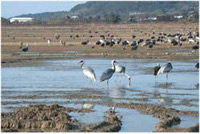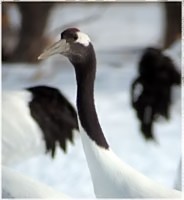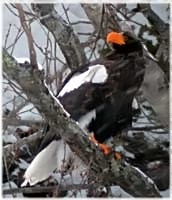JAPAN 2003 , February 6th - 18th
...with Mark Finn
 |
Photo: Cranes at Arasaki |
This
was our fourth winter visit to Japan. Highlights included five species of
crane at Arasaki in Kyushu including annual vagrants in Sandhill, Common
and Demoiselle Cranes. Further north at Saga above average numbers of wintering
Saunder's Gulls and Falcated Ducks. Inland at Mi-ike we encountered Baikal
Teals for a third successive winter. Further north in Japan we visited the
winter wonderland of Hokkaido. White-tailed and Steller's Sea Eagles in almost
every harbour. The latter species at Notsuke Hando observed on floating sea
ice at 30 metres. A wonderful experience as they passed another four eagles
on a 'static' ice flow. Close views of seaducks will linger in the mind particularly
Long-tailed and Harlequin Ducks, Black Scoter, Common Goldeneye, Goosander
and Red-breasted Mergansers. However the dancing Red-crowned Cranes delighted
everyone as they danced in the snow. A large and beautiful crane with a restricted
range. Near Furen-ko we visited a closed area for the rare and unknown Blakiston's
Fish Owl. We waited in freezing conditions before a huge rectangular shape
glided over the forest on a moonlit night. Perched on top of a TV aerial.
This delighted all of us. Just before leaving another owl came in and fed
on a fish left on a feeding table. Fantastic views by flashlight, we left
a happy and contented group.
In total we travelled 945 kilometres in Kyushu and 800 in Hokkaido. I hope
the following tour report brings back happy memories of an enjoyable tour in
the land of the rising sun.
February
6th/7th: London/Newcastle - Frankfurt - Tokyo (Narita and Haneda Airports)
- Oi Nature Reserve
Weather: Sunny and clear, 8c
We
met at Heathrow Airport Terminal 2 for our flight with Lufthansa to Tokyo
via Frankfurt. Our journey took us over Siberia and down to Vladivostock
before heading over the Sea of Japan and the Japanese Alps to Tokyo's Narita
airport. Akira, my ground agent was there to meet us and help with luggage
and general enquiries. The bus journey passed by central Tokyo to Haneda
Airport where we had lunch. Afterwards we made the short journey to our hotel
opposite Tokyo fruit and vegetable wholesalers. Checked in and made our way
through the vegetable warehouse to Oi Nature Reserve. Grassy areas held Dusky
Thrush, White-cheeked Starling and Brown-eared Bulbuls. The first area of
pools lured Common Pochard, Tufted Duck, Spot-billed Duck and Eurasian Teal.
Overhead parties of Black Kites. The next group of pools had muddy edges
providing feeding areas for Common Greenshank and Common Sandpipers. Walked
towards the entrance gate and into a quiet area of Oi. From the hide Brown
Thrush and Azure-winged Magpie. Retracing our steps to the entrance added
Bull-headed Shrike and Oriental Greenfinches. Tomorrow we head south to Kyushu
in western Japan and its avian delights.
February
8th: Tokyo - Kagoshima - Road 50, 53 and 248 - Izumi - Arasaki Crane Reserve
East and West sections
Weather: Steady rainfall, heavy at times, and 11c
Left
the hotel on the 0550 bus for the short journey to Haneda Airport and our
flight down to Kagoshima. Haneda was extremely busy with passengers flying
to all parts of Japan. Arrived in Kagoshima where heavy and persistent rain
greeted us (to stay with us all day). Picked up the minibus and travelled
to Izumi via Roads 504, 50, 53 and 248. The junction of the last two provided
us with the opportunity of birding riverine habitats next to an old dam complex.
Parked near a bridge where Black-faced Buntings were particularly common.
On the river good numbers of Gadwall, Eurasian Wigeon and Eurasian Teal.
Rocky areas had at least two Long-billed Plovers. Faster flowing areas with
protruding rock held Japanese, Black-backed and Grey Wagtails, Brown Dipper,
Common Kingfisher, Common and Green Sandpipers. Rain started to fall heavily
as we headed towards Izumi. Turned off onto road 48 without much success.
Checked in at our base in Izumi and on towards Arasaki Crane Reserve. Higher
than usual numbers of Hooded and White-naped Cranes greeted us with their
distinctive calls. Mixed up with them were Little and Great Egrets, Northern
Pintail, Grey Heron and Black Kite. Stubble fields had Japanese Skylark,
American Pipit, Common Snipe and flocks of Eurasian Wigeon. Checked the eastern
end with more cranes plus Bewick's Swan (rare), Herring Gull, Common Shelduck
and flocks of Oriental Greenfinches. Back to base as the weather closed in.
An enjoyable and profitable ended with a pleasant meal in a local restaurant.
Lets hope the weather improves tomorrow with a planned visit to the woodlands
along road 48.
February
9th: Road 48 - Arasaki Crane Reserve and environs
Weather: Clear and sunny, 14c
An
early start along Road 48 as dawn started to break. The best area was before
the tunnel a steep wooded hillside with mature trees and roadside. A pair
of Pygmy Woodpeckers showed well in a bare tree. Seeding grasses attracted
Yellow-throated, Black-faced and Meadow Buntings. Back to Izumi for breakfast.
Checked the river where waterbirds present included Great Crested Grebe (rare
in Japan), Eurasian Wigeon, Eurasian Teal, Gadwall and Spot-billed Ducks.
On a shingle island a group of Japanese Cormorants. In the river itself Slaty-backed
and Herring Gulls. Headed towards Arasaki stopping near a farm adjacent to
a stand of mature trees. Latter habitat holding Dusky Thrush, Bull-headed
Shrike, Oriental Greenfinch and a splendid Hawfinch. Walked along farm roads
at the eastern end of Arasaki. Shallow pools here attracted Grey Heron, Common
Shelduck, Hooded and White-naped Cranes, Black-faced Spoonbills, Kentish
Plover and Dunlin. In the river estuary an immature Common Gull and the commoner
ducks. At the hide I managed to locate Common and Sandhill Cranes annual
visitors to Arasaki each winter. After lunch we drove along another estuary
with a highlight being an adult Crested Kingfisher perching on harbour walls.
Flooded rice fields lured at least two Intermediate Egrets. En route to the
crane centre we added Common Kestrel, Rustic, Black-faced, Chestnut-eared
and Meadow Buntings. Explored another area near a barrage with a habitat
of bamboo and mature woodland. On the track Pale Thrushes and in nearby scrub
Japanese Bush Warblers. An Osprey flew overhead looking for fish. Ended the
day in front of the crane centre adding an adult Demoiselle Crane our fifth
crane species of the day.
February
10th: Izumi - Road 447 - Saga - Ariake-se
Weather: Overcast and cloudy, 14c
Headed
east towards the Kyushu Expressway the main highway northwards. At the end
of road 447 I located a dark phase Daurian Jackdaw in amongst a flock of
Rooks. It took us a long time to reach Ariake-se a vast area of mudflats
and fish farms with adjoining agricultural land. The road system being totally
congested and slow. On our arrival high numbers of Saunder's Gulls hunting
for crabs on the flats. Waders were numerous including Grey and Kentish Plovers,
Eurasian Curlew, Common Greenshank and two Bar-tailed Godwits. A nearby ditch
held a winter plumaged Marsh Sandpiper. Wildfowl were again present in high
numbers comprising of Northern Pintail, Mallard and reasonable numbers of
Falcated Ducks. After lunch we explored fields and ditches for birds. Highlights
included summer plumaged Bramblings, Meadow, Black-faced, Rustic and Reed
Buntings, hundreds of Dusky Thrushes, Daurian Redstart, Bull-headed Shrike,
Oriental Greenfinches and American Pipits. Explored the airport side, which
was quiet apart from a flock of White-cheeked Starlings and hunting Eurasian
Kestrels. Headed for home a long journey especially through Saga. Stopped
along route 3 for a meal before arriving back at Izumi at 2235.
February
11th: Izumi - Okuchi - Mi-ike.
Weather: Overcast with afternoon showers, 15c.
An
early start to visit Mi-ike an area of woodland surrounding a volcanic lake.
En route we stopped at Okuchi where we located a Daurian Jackdaw amongst
the Rook flock. Arrived at Mi-ike and headed towards the campsite a quiet
and peaceful area in the winter months. We quickly located a pair of White-backed
Woodpeckers plus Pygmy Woodpecker, Eurasian Nuthatch, Willow, Great, Varied
and Long-tailed Tits. Grassy areas lured Dusky and Pale Thrushes, Black-faced
and Yellow-throated Buntings. On the lake itself several hundred ducks were
present. Careful scanning brought us three Baikal Teal a rare but regular
visitor to Mi-ike. Other species present included Little Grebe, Spot-billed
and Tufted Ducks, Eurasian Wigeon, Eurasian Teal, Gadwall and Northern Shoveler.
In the campground carpark a group of Goldcrests fed in the trees with Japanese
White-eyes. Lunch taken near a shrine. Steady rain started to set in as Andrew,
Doug and myself set off around Mi-ike lake in search of birds. A pair of
Eurasian Jays flew over the forest. The path along the lake produced Red-flanked
Bluetail, Pale Thrush, and close views of Varied Tit, Bull-headed Shrike,
Japanese Bush Warbler and excellent sightings of Baikal Teal. Brief flight
views of Japanese Grosbeak. Afterwards we visited 'The Boys and Girls Club'
a district of farmland. Large flocks of Rustic and Meadow Buntings and a
pair of Common Buzzards (race japonicus). Headed for Izumi after a brief
look at another location for retired workers.
February
12th: Izumi - Mi-ike - Kagoshima - Tokyo - Mito - Oarai Port
Weather: Pleasant in Kyushu, cool in Tokyo. 7c/14c
Revisited
Mi-ike with the same results as yesterday. A little disappointing as we missed
the endemic woodpecker. At Kagoshima we made the flight to Tokyo where Akira
met us. Taxi to Ueno Station and an express train to Mito around 150 kilometres
Northeast of Tokyo. Our ferry left fifteen minutes late for Tomakomai. Hokkaido
awaits us tomorrow plus seawatching in the North Pacific Ocean.
February
13th: North Pacific Ocean - Tomakomai
Weather: Clear and sunny but with chill northerly winds, 1c
On
deck at 0615 as the ship approached Sendai. Birds were few and far between
but included Slaty-backed, Black-tailed, Herring, Common and Glaucous Gulls.
Along the coast of Iwate we recorded Pacific Diver, Red-necked Grebe, Common
and Brunnich's Guillemots, Rhinoceros Auklets and a surprise with a group
of Brent Geese flying out to sea. Stopped at 1215 for lunch. Blizzards and
strong winds affected the afternoon. Significant numbers of Black-legged
Kittiwakes present along the Honshu coast. The best birding being Tsugaru
Strait with a few fishing trawlers present. Apart from thousands of gulls
we found Ancient Murrelet, Least Auklet, Red-breasted Mergansers and the
commoner gulls. Docked at Tomakomai on time and transferred to our hotel
at Chitose.
February
14th: Chitose - Kushiro - Akkeshi - Kiritappu Harbour and Cape - Road 142
- Nemuro.
Weather: Sunny with occasional cloud and snow showers, -7c/-2c.
 |
Checked in with JAS for the short internal flight to Kushiro in eastern Hokkaido. Picked up our 4x4 minibus and made the short journey up road 53. At Tsurui up to 70 Red-crowned Cranes entertained us dancing in the snow and feeding on grain put out by local farmers. |
After
this magical experience we headed east along route 44 to Akkeshi. On the
road to Kiritappu we stopped to observe birds present in Akkeshi Harbour.
Large numbers of wildfowl present including Whooper Swan, Common Goldeneye,
Red-breasted Merganser, Goosander and Greater Scaup. On the ice resting White-tailed
and Steller's Sea Eagles. Kiritappu Harbour was our next stop where we had
close views of Black Scoter, Long-tailed and Harlequin Ducks and a flock
of wintering Dunlin. The quay offered us close views of Slaty-backed, Black-tailed
and Glaucous Gulls. Beyond Kiritappu the cape of the same name is located.
Stopped at a feeding station to observe Asian Rosy Finches and Eurasian Tree
Sparrows. At the cape itself loose flocks of Black Scoters on the sea with
Pelagic Cormorants. We took the coast road towards Nemuro passing through
woodland and iced up harbours. Visited the nature centre at Furen-ko to obtain
information about birds present in the Nemuro and eastern Hokkaido areas.
Prospects look good for the next two days both for birds and weather. As
we made the journey to Hotel Cairn a blizzard blew in from the Sea of Okhotsk,
lets hope it blows itself out.
February
15th: Nemuro - Cape Nosappu (Nemuro eastwards) - Furen-ko - Roads towards
Ochisii and Route 44
Weather: Sunny and cold, -4c/-9c
We
started the day by heading to Nemuro the most north easterly town in Japan
and onto Cape Nosappu. En route to Cape Nosappu we stopped at various locations
along the rocky coastline. The first producing Slaty-backed, Glaucous, Glaucous-winged
and Herring Gulls. Offshore White-winged and Black Scoters, Harlequin Duck,
Goosander and Red-breasted Mergansers. Our next stop was reached by turning
right past a village towards the sea. Parked by a farmhouse adjacent to steep
cliffs and a rocky beach. The sea here held the usual ducks plus Marbled
Murrelet, Crested Auklet and Spectacled Guillemot. The harbour before Cape
Nosappu held Red-faced and Pelagic Cormorants. At the cape itself we birdwatched
from the lighthouse overlooking the disputed Kurile Islands (held by Russia).
The sea here had vast areas of floating pack ice. Good numbers of auks, cormorants
and seaducks. After lunch we visited the Furen-ko Nature Reserve Centre.
Feeders here luring Great Spotted and Pygmy Woodpeckers, Marsh, Willow, Great
and Long-tailed Tits, Hawfinch, Eurasian Nuthatch and Brown-eared Bulbuls.
For the rest of the afternoon we cruised around backroads looking for birds.
A house with feeders produced Brambling. Ended the day looking for owls without
success.
February
16th: Nemuro - Odaito - Notsuke Hando - Rausu - Furen-ko
Weather: Clear and sunny with snow in Rausu, -1c/1c
Left base at 0730 to pick up supplies and fuel in Nemuro. Headed west and then north along the Shiretoko Peninsula towards the remote town of Rausu. A detour along a side road back towards Furen-ko was good for hundreds of Muck Deer, Asian Rosy Finch and on the pack ice dozens of Steller's Sea Eagles. Next village north has a harbour attracting birds. Interesting sightings included a male Smew, Goosander, Common Goldeneye and a range of gulls. Odaito was again good for close views of Whooper Swan and Northern Pintails. Notsuke Hando was quiet to start with but the lower end produced several birding experiences. The best being Steller's and White-tailed Sea Eagles resting on ice flows.
 |
Photo: Steller's Sea Eagle |
A
'magic moment' was a juvenile and adult Steller's Sea Eagle resting on a
moving ice flow passing below four eagles perched on another 'static' flow.
On the sea itself White-winged and Black Scoters, Spectacled Guillemot, Goosander
and Common Goldeneye. Lunch taken en route to Rausu with a pale Peregrine
Falcon hunting over woodland. Rausu itself produced Brown Dipper, Glaucous
Gull and Harlequin Duck. Back to Furen-ko where we met the Japanese ranger
from yesterday evening. We followed him to a closed area of Furen-ko. Our
finale was a juvenile Blakiston's Fish Owl perched on top of a television
aerial. Later an adult came down to a fish laid out on a table. Fantastic
views of a rare and relatively unknown owl. Tomorrow we head back to Kushiro
and a flight back to Tokyo.
February
17th: Nemuro - Cape Nosappu - Kushiro - Tokyo.
Final total 138
Weather: Sunny and clear. Afternoon blizzards at Kushiro, -3/5c.
Checked
out of Hotel Cairn and headed east towards Cape Nosappu. Overnight snowfalls
had made the roads icy and slippery in places. At the cape we were surprised
to find extensive areas of sea ice in comparison to clear waters of two days
ago. Usual birds present with a noticeable increase in Harlequin Duck and
Black Scoter numbers. Left the area at 0900 for Kushiro Airport. A slow journey
due to traffic and weather conditions. After dropping our rental vehicle
off we checked in with JAS for the flight down to Tokyo. Much to our surprise
heavy blizzards set in causing severe delays and in some case cancellations
of flights. Fortunately we left at 1640 two hours behind schedule (little
did we know that we were the last flight out of Kushiro). The airport was
later closed due to further heavy snowfalls. At Haneda airport Akira met
us before boarding a bus to Narita airport. Our journey took us through the
new Tokyo Bay tunnel and causeway avoiding the congestion of metropolitan
Tokyo. Checked in at the Washington Hotel for our final night in Japan.
February
18th: Tokyo - Frankfurt - Heathrow
A long travelling day started at 0745 with a bus to terminal 2. Check-in with Lufthansa was quick and efficient. Departed twenty minutes late for Frankfurt and finally London. The end to an enjoyable birding tour of Japan.
For details of the full species list or to request further information about the next time we will be offering this trip. Contact us at enquiries@birdwatchingbreaks.com.